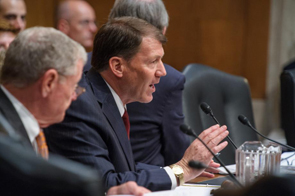A bill that would exempt animal feeding operations from reporting their air emissions should be able to move through the Senate quickly, given its bipartisan support and a looming deadline from a federal appeals court.
“Clearly, it’s popular right now, and I think right now we’ve probably got more than enough votes to override a cloture attempt,” Sen. Mike Rounds, R-S.D., said following a hearing Thursday on S. 2421, the Fair Agricultural Reporting Method (FARM) Act. There is no bill yet in the House, but advocates say they're expecting one to be dropped next week.
Currently, 33 senators – 21 Republicans and 12 Democrats – have cosponsored the bill, including two Democrats who serve on the Environment and Public Works Committee, ranking member Tom Carper of Delaware and Tammy Duckworth of Illinois. Delaware is ranked eighth among the states in broiler production, while Illinois is fourth in hog production.
“We’ll do everything we can to move it forward as expeditiously as possible,” Rounds said.
On May 1, the D.C. Circuit Court of Appeals is expected to issue its mandate for an opinion it issued last year that found EPA’s 2008 exemptions from reporting under the Emergency Planning and Community Right-to-Know Act (EPCRA) and Comprehensive Environmental Compensation and Liability Act (CERCLA, also known as the Superfund law) were illegal. (The mandate puts the ruling into effect.)
The bill would exempt animal feeding operations from CERCLA reporting requirements. EPA has already issued guidance interpreting EPCRA as excluding farms that use substances in “routine agricultural operations” from reporting under that law.
“With the FARM Act, we are helping provide certainty to farmers by legislatively exempting all farms under CERCLA, as was done by EPA in its 2008 rule,” Carper said.
But the hearing also highlighted the difficulty of lumping all ag operations together when regulating air emissions. Todd Mortenson, a rancher from South Dakota who was praised by Republicans and Democrats at the hearing for his commitment to environmental stewardship – more than 90 percent of his 19,000-acre spread is covered by native grasses, shrubs and trees, and herbaceous flowering plants known as forbs – said he could understand how someone living near a large Concentrated Animal Feeding Operation (CAFO) might have a different perspective on regulation.

Sen. Mike Rounds, R-S.D.
Sen. Cory Booker, D-N.J., after paying his respects to Mortenson for the way he manages his land, elicited agreement from the rancher on two points he made: first, that “there’s a fundamental difference” between the impact of hog CAFOs discussed by Floyd County, Iowa, supervisor Mark Kuhn at the hearing and impacts from his operation; and second, “why folks would be appealing to the government to please do something about the health and safety risks that they’re experiencing as a result of these CAFOs.”
“Yes I can understand that,” said Mortenson, who testified on behalf of the National Cattlemen’s Beef Association. Mortenson added that he was not an expert on CAFOs but was simply testifying as a rancher from Stanley County, South Dakota, who is “scared to death” of having to try to estimate air emissions from his sprawling ranch.
“It’s just a reporting nightmare,” Mortenson said of the time and effort required to estimate emissions. As an emergency responder himself, Mortenson said he saw no benefit to imposing reporting requirements on ranchers in his state.
Booker said “a pasture-based rancher like you should not have to do this kind of emissions reporting.”
Also testifying was Bill Satterfield, executive director of Delmarva Poultry Industry Inc., who said that ammonia emissions from poultry and egg operations “are at very low levels and they dissipate rapidly into the air.” If allowed to stand, CERCLA would require animal operations to report when their emissions of hazardous substances like ammonia and hydrogen sulfide exceed 100 pounds within a 24-hour period.
For more news, go to www.Agri-Pulse.com.


